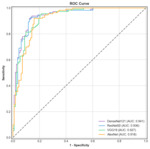Keywords:
Oedema, Computer Applications-General, Computer Applications-Detection, diagnosis, Digital radiography, Cardiovascular system, Artificial Intelligence
Authors:
J. W. Luo, J. J. R. Chong; Montreal, QC/CA
DOI:
10.26044/ecr2019/C-3644
Results
The best performing classifier was DenseNet121,
which obtained an AUC of 0.941 without ensembling or transfer learning.
The three other convolutional architectures tested,
ResNet50,
VGG19,
and AlexNet respectively had an AUC of 0.936,
0.927 and 0.918 (Figure 2).
Transfer learning boosted these AUC figures to 0.963,
0.945,
0.932 and 0.929 respectively (Table 1).
A majority voting ensemble of 3 DenseNet121 and 2 ResNet50 networks with weights pre-initialized on the NIH dataset obtained an AUC of 0.973 (Table 1).
Our models are able to accurately detect cardiomegaly and achieve adequate performance for the detection of cardiomegaly.
However,
our results are not directly comparable with those reported on the NIH dataset,
as we performed filtering for PA view only,
and constructed our cases and controls following a manual review.
The NIH dataset,
on the other hand,
relied purely on an automated NLP-based ontology algorithm in order to automatically generate the labels for their 14 cases,
which therefore contains ground truth noise of up to 30% for certain conditions [2].



